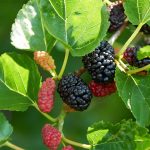 The purplish-black fruit of the mulberry tree.
The purplish-black fruit of the mulberry tree.
Handsome tree bearing sweet, juicy berries that make fine conserves and drinks, including mulberry wine. Rootbark decoction is a traditional remedy for tapeworms. Hardy in southwestern Ontario and coastal British Columbia, Canada.
A fruit of crimson to purplish-black hue bearing a resemblance to a blackberry, although it grows on a distinctly distinct plant. Despite its potential for raw consumption and suitability for culinary use, this fruit is highly perishable, leading to its infrequent utilization.
Prepare to discover the allure of a fruit akin to the blackberry, yet boasting a larger form—the magnificent mulberry. Originating from Asia, the black mulberry takes center stage as the pinnacle of flavor among its counterparts. Meanwhile, the red mulberry, a variety native to America, adorns itself with vibrant red berries that transition to a deep purple hue upon reaching peak ripeness. Mulberries unveil a world of culinary possibilities, both in their raw state and as transformed delights. Enjoyed as a luscious dessert, they harmonize splendidly with a sprinkle of sugar. Alternatively, these succulent gems can be stewed in syrup, transformed into delectable pies or flans, canned for preservation, or even crafted into tantalizing wine. It is worth noting that due to their low pectin content, mulberries alone may not produce satisfactory jams or jellies. However, when paired with apple, their enchanting qualities can contribute to the creation of delightful preserves. Immerse yourself in the splendor of mulberries, exploring the multitude of ways to experience their tantalizing flavors.
